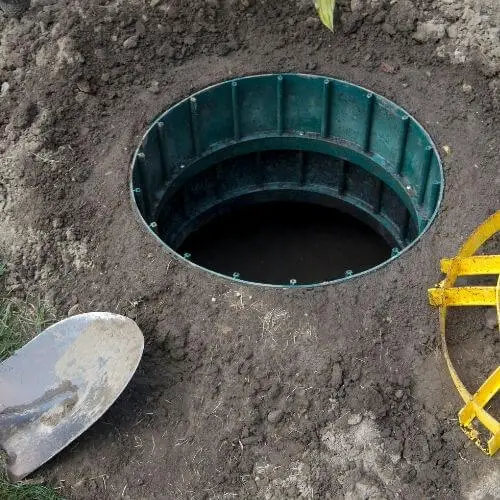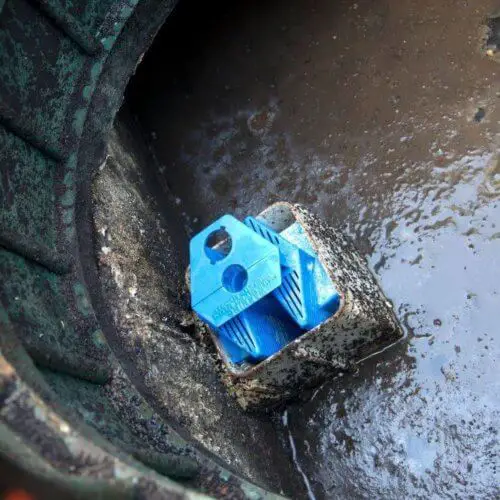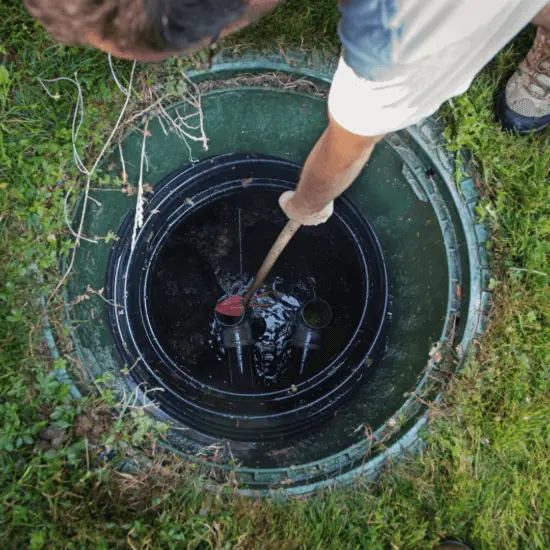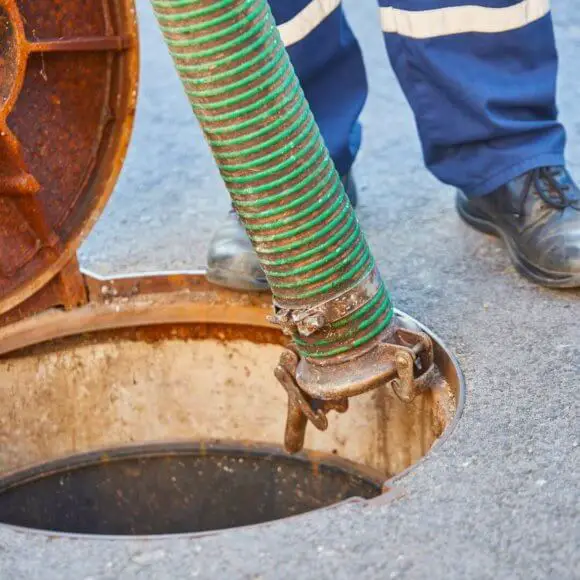If you need instructions on how to check septic tank is full, you’ve come to the right place.
A septic tank is what keeps your whole plumbing system in the house functioning properly. A fully functioning septic tank is responsible for handling all of the wastewater coming from your house.
When out of balance, a septic tank can cause so much damage that it is hard to recover from it. Not to mention the awful smell in your yard that can cause the neighbors to complain.
That’s why a routine checkup and pumping of the septic tank are highly advisable. To help you start on the right track, we’ve gathered all of the helpful information on septic tank maintenance.
What Happens When Septic Tank Is Full?

Since there is some confusion around what makes a septic tank “full”, we need to start from the basics.
Let’s first shortly explain how a septic tank works. The main purpose of the septic tank is to decompose all of the waste coming from your home’s main water line.
All of the waste from your kitchen and bathroom sinks, bathtubs, toilets, and showers goes to the main waste line. The septic tank is connected to this plumbing line via wastewater lines.
When this waste reaches the septic tank, it then separates into three layers inside the tank. The lower layer consists of sludge (solids), the water is in the middle, and the oil makes up the top layer of the tank. [1]
What helps the tank in this process is the helpful bacteria present inside the tank. It’s helpful to increase the bacteria in the tank when there is not enough or the balance is distorted.kkkkk
When this process is finished, the remaining liquid passes through the pipe sitting near the top of the tank. This liquid then travels to the drain field and is also released through the soil.
The holding capacity of the tank will depend on its size. There are septic tanks sizing from 1000 gallons to even 3500 gallons.
What happens when a septic tank is full is that the wastewater present in the tank surpasses the tank’s capacity. The extra water has nowhere to go, so it will most likely back up into your home or end up in your yard.
If your septic tank or plumbing pipes have any cracks present, then the extra water will flood your yard through these cracks.
If not, then the water will start flooding your sinks, toilets, and other fixtures around the house.
What Does a Full Septic Tank Look Like?

Obviously, a full septic tank is the one that needs pumping. However, there are some exceptions to this rule.
It might be hard to check if the tank is full in order to schedule the pumping. Some signs are hard to follow, and you can’t be fully sure until you open the tank lid.
What’s even more confusing is that a full septic tank is what a fully functional septic tank looks like. In order for the wastewater to leave the tank, the water level has to be high inside the tank at all times.
That’s because the outlet pipe where the wastewater exits are placed near the top of the tank. That being said, a septic tank is somewhat full all of the time.
A second scenario is the one where the sludge at the bottom of the tank has accumulated way too much. This sludge is supposed to be broken down by the bacteria in the tank.
When there is not enough bacteria or something non-flushable is flushed, then the sludge builds up. Sometimes, even toilet paper can build up at the bottom of the tank – which is another reason why pumping is advisable.
Pumping the septic tank should be done every 3-5 years or so. [2] When a tank gets pumped, the tank gets emptied, so the built-up sludge gets removed as well.
A full septic tank can be easily noticed once you remove the tank lid.
The overfilled tank is the one that has the water all the way to the lid. This is usually followed by a drain field not accepting water from the tank.
Otherwise, you can notice a full septic tank by following a few of the signs that appear when the tank is full. Let’s see what those are.
Signs a Septic Tank Is Full
- Sewer Backup – This is one of the most common signs of a full septic tank. The wastewater has nowhere else to go, so it will come back into your toilets or sinks. A sewer backup can also be an indicator of blockages due to tree roots.
- Sewage Smells – If you notice sewage smells outside the house, this is another common telltale sign of a full septic tank. Most often, these sewage smells are present because of a leak on the sewage line somewhere in your yard. However, it could also mean that your septic tank is full.
- Slow Drains – If you notice that the sink, shower, toilet, or all of these together are draining slowly, this is also a sign. Slow drains often point to clogs present in your sewage system. If you already tried to unclog the drains and it’s still draining slowly, then it’s the septic tank that’s full.
- Green Lawn – Sewage acts as a great fertilizer for the plants. [4] That being said, if you notice a lush green part of the yard all of a sudden, chances are that’s where the leak in the sewer line is.
- Pooling Water – The most obvious sign of the full septic tank is the pooling water around it. However, look for the standing water across your yard, too, as the water may come up further down the sewer line.
- Gurgling Water Sounds – Gurgling sounds may also be connected to the sewer backup. When that wastewater has nowhere to go, it comes back into your plumbing system. This clashes with the upcoming wastewater, which ruins the balance and causes gurgling sounds.
How to Check Septic Tank is Full?

There are two types of measurements taken to inspect the septic tank level. Inspecting the septic tank is necessary in order to get on the regular schedule of pumping the tank.
During these inspections, you will get a more precise idea of the level of sludge and scum buildup inside the tank.
The level of sludge and scum should never surpass the certain level in the tank or get near the inside or outside baffles. If it does, the pumping is needed immediately.
Inspecting the Scum Level Inside the Tank
When you measure the scum level, you measure the distance between the bottom of the scum layer and the bottom of the outlet section. First, find your septic tank.
- To start, you will need a reference point. For that, you can lay a stick on the ground across the hole opening.
- Create a stick in an L-shape by using PVC pipes. For this, you will need to first attach the 90-degree elbow of the pipe to a six-inch-long PVC pipe.
- This altogether should next be attached to the bottom of the six feet long pipe.
- Then, gently push this stick into the first section. The goal is to find the bottom of the baffle, so you should push the stick through the scum layer.
- When you find the bottom of this baffle, mark the stick to get a reference point.
- From this point, you should gently raise the stick until you feel or see the pipe elbow hitting the bottom of the scum layer.
- That’s when you should mark the stick again – this is the bottom point of the scum layer.
Now that you finished the inspection of the scum level, you should have two reference points on your stick. The distance between them should tell you if the tank needs to be pumped or not.
If the distance is three inches or even less, then the tank should get pumped. It should also get pumped if the scum level seems to be too close to the outlet of the section. [5]
IMPORTANT NOTE: Make sure you save the scum stick in order to compare it to the sludge stick later.
Inspecting the Sludge Level Inside the Tank
Measuring the sludge level inside the tank also gives you an indication of the distance between certain elements inside the tank. This measuring style will indicate the distance between the top of the sludge and the bottom of the outlet of the section.
- Take a pipe with a length of at least 8 feet long. Then, wrap the white towel or a white cloth around its edge. This cloth should cover about three feet of the stick/pipe.
- Then, lower the stick through the outlet baffle in the first tank section. This will allow you to get to the sludge level without having to push through the layer of scum.
- When you reach the bottom of the tank, make sure to wait for a few minutes. This allows the towel or a cloth to absorb the sludge.
- While waiting, you should mark the stick on the entrance – this will serve as a reference point later.
- Then, pull the stick out of the tank carefully. You should be able to notice the sludge layer on the white rag you wrapped around the stick.
- This point, as well as the previous mark you made on the stick, serves as a reference point for distance measurement.
The next step is to compare the scum stick to the sludge stick. To do so, the highest marks you made on both sticks have to be parallel to one another.
The next distance is measured from the bottom part of the scum stick to the dark mark on the towel of sludge stick. The tank needs to be pumped if the distance is about 12 inches or less.[6]
What to Do if Septic Tank Is Full?

If the water in the tank surpasses the tank’s capacity, then the tank is “overfull”. After the pumping, the septic tank needs to be refilled to the right amount in order to function.
Depending on the severity of the situation, you will either hire a plumber or a septic service for a tank pumping.
A septic company will review your septic tank annually so you don’t have to worry how to check septic tank is full.
A septic service will arrive with special equipment in order to empty out your septic tank. This includes a truck with a vacuum and a hose.
This hose is inserted into a tank in order to suck out all of the wastewater from the tank. Some additional equipment is often used in order to break down the solids inside the tank and make this process easier.
The average cost for a septic tank pump-out is about $200-$500, depending on your location.
Septic Tank Full After Rain
Heavy rainfalls often interfere with the way that septic tank works. This is because the drain field is often saturated with water after the rainfall. [7]
The liquid from the tank has to travel to the drain field. When the drain field is saturated, that same water has nowhere to go. That’s why it often starts backing up and traveling back to the plumbing system of the house.
Luckily, there is a way to prepare the septic tank in order for it to withstand heavy rains. You can do so by following steps to increase the bacteria in the septic tank prior to the rainfall.
If you constantly have septic tank problems, it might be helpful to read about septic system alternatives. When installing a new system, it’s beneficial to know the factors that determine how long a septic system will last.
Read Also: Is Borax Safe For Septic Tanks
The Takeaway
Sometimes the balance of the septic tanks can be set off by rainfalls or other similar circumstances. This is why it’s helpful to know how to check septic tank is full by yourself.
In this article, we’ve offered a few simple ways to measure the scum and the sludge levels in the tank. You can use this information to help you out in setting a proper schedule for a regular septic tank cleanout.
Read Next: Septic Tank Problems

Michael Davis is a heating & plumbing expert who currently works as independent contractor in SC. He also writes for Plumbertip.
For almost 10 years he worked on various plumbing tasks across South Carolina.



